So you’ve bought your pull-up bar, now what? We’ve done the hard work for you by detailing the 10 best pull-up bar exercises below to get you started. Read on to become a pull-up expert!
Pull-ups are one of the most effective pull up bar exercises to build upper-body strength and develop functional fitness. They can often feel like an elusive bodyweight exercise reserved for professionals and athletes but never fear! We are here to help!
Maybe you can already do pull-ups? But, what about the more advanced movements below? Working on your weak links and using a progressive approach will have you doing any of the pull-up variations below in no time at all.
The exercises we’ve picked below are great pull up bar exercises for beginners, challenging ab exercises for intermediate users, and some cardio-based moves to add some variety. Let’s see why the pull-up bar really is one of the best pieces of kit you can buy for your home gym!
What Are The 10 Best Pull-Up Bar Exercises To Develop Full Body Fitness?
We’ve broken down the 10 best pull-up bar exercises below, giving you detailed instructions on performing each exercise correctly. We’ve provided a good mixture of strength-building exercises and core exercises on a pull up bar.
No time? Take a quick look at the list below:
- Dead Hangs
- Negative Pull-ups
- Wide-grip Pull-ups
- Close-grip Pull-ups
- Burpee Pull-ups
- L-sit Pull-ups
- 90-degree Pull-ups
- Hanging Knee Raises
- Around the Worlds
- Inverse Pull-up Ladder Circuit
The exercises are presented in no particular order, with each providing a great way to build stubborn muscle when programmed correctly. Let’s take a closer look!
Dead Hangs
Dead hangs help to build foundational pull-up strength. During a dead hang, you learn how to grip the bar and support your body weight in the same position as a normal pull-up. They are great as part of a well-organised pull-up progression plan.
GRAVITY FITNESS PULL UP BAR
Portable, versatile, home fitness
- Highly versatile- suitable for a full range of exercises including pull ups, dips, leg raises, incline press ups and front and back levers
- Extended height: 192cm
- Compact position height: 120cm
- 3-year warranty against manufacturer defects
- Carry bag included
ONLY £139.95 £109.95
Also don’t worry, you’re not actually dead!
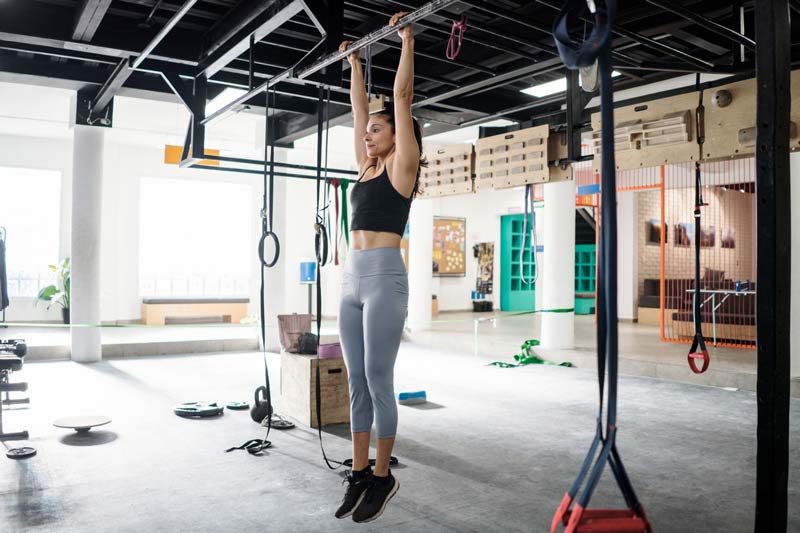
How to:
- With your hands shoulder-width apart, grasp the pull-up bar and inhale.
- Relax into a hanging position with your arms straight and feet off the floor.
- Pull your shoulder blades down and back. Engage your upper back muscles to bring your chest and head up.
- Hang for the allotted time, exhaling between repetitions.
Negative Pull-ups
Dead hangs and negative pull-ups provide great pull up bar exercises for beginners before progression to the harder movement patterns. Negative pull-ups help you practise the movement without needing the strength to bring your body above the bar.
Using pull-up resistance bands is another great way to reduce the exercise difficulty. Take a look at this useful guide to learn more.
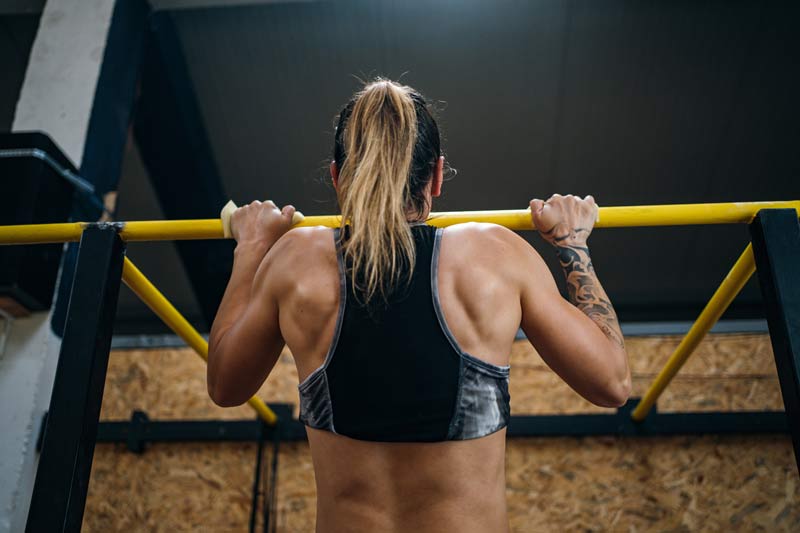
How to:
- Stand on a raised surface such as a plyo box or chair. Grasp the pull-up bar with a slightly wider than shoulder-width overhand grip.
- Take a deep inhale and pull your body up until your chin is over the bar. Jump up and use your momentum if needed.
- Slowly lower yourself from the top position until your arms are straight.
- Release the bar, exhale, and drop to the ground.
- Return to the starting position and repeat.
Wide-grip Pull-ups
Wide-grip pull-ups are a great way to engage your lats more compared to using a narrower grip. If you struggle with lat engagement, try the wide-grip version.
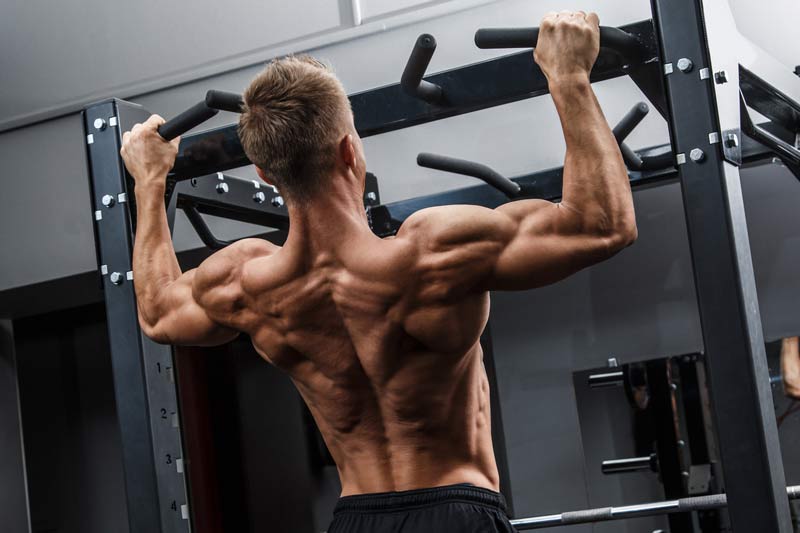
How to:
- Grasp the bar with a wider than shoulder-width grip. Ensure your hands are pronated.
- Take a deep inhale and depress your shoulder blades. Brace your core whilst you look forward.
- Pull your chin toward the bar until your lats contract.
- Slowly lower your body down to the starting position while you exhale and repeat.
Close-grip Chin-ups
Close-grip chin-ups use a closer grip with a supinated hand position. The different movement pattern makes them great for working your upper back, biceps, and core.
An old bodybuilding staple that’s slightly different to a pull-up.
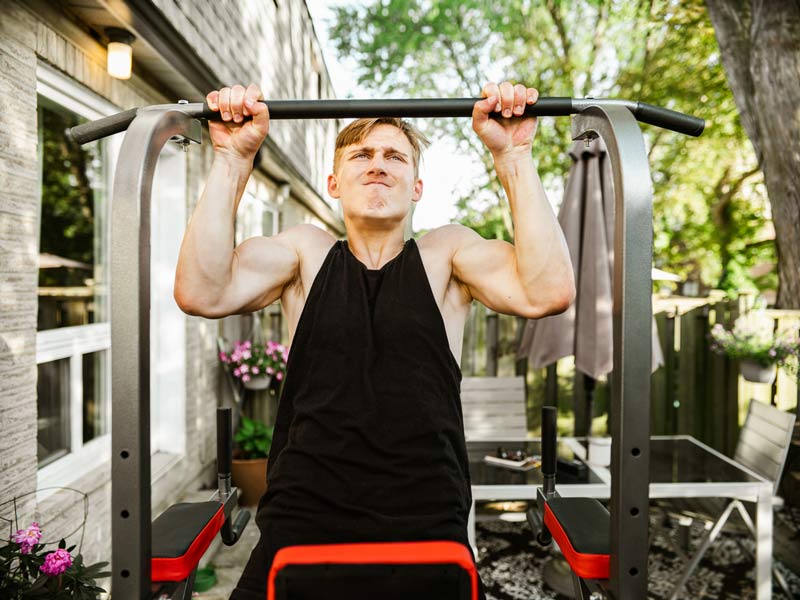
How to:
- Grasp the bar with your arms close together and your palm facing toward your body.
- Take a deep inhale and brace your core.
- Pull your body up until your chin is level or above the bar.
- Hold and return to the start position whilst exhaling.
Burpee Pull-ups
Burpee full-ups provide a fantastic method to work both your upper body and lower body in one movement pattern with some added cardio work. If you want to build conditioning, these hit the spot nicely!
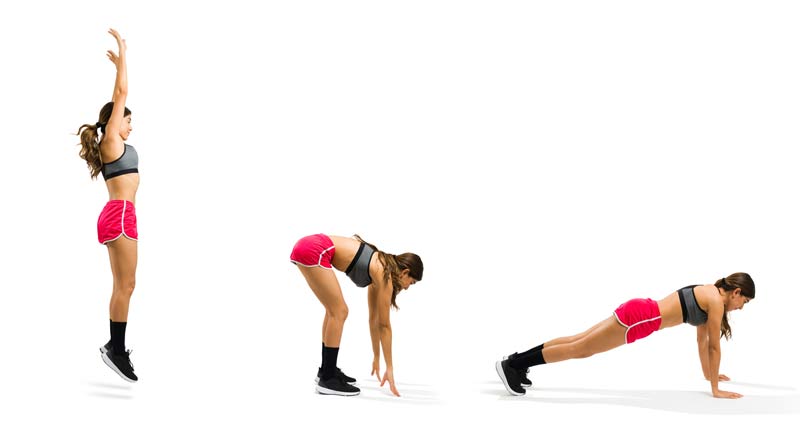
How to:
- Stand in front of a pull-up bar. Take a deep breath in and drop into a squat position using your hands on the floor.
- Push your legs back and perform a press-up. Bring your knees back to your chest and stand back up.
- Jump into the air to perform a pull-up. Exhale and return to the starting position.
L-Sit Pull-ups
L-sit pull-ups are an advanced gymnastics pull-up movement that allow you to work on controlling your core and mind-muscle connection. Have a go and let us know how you do.
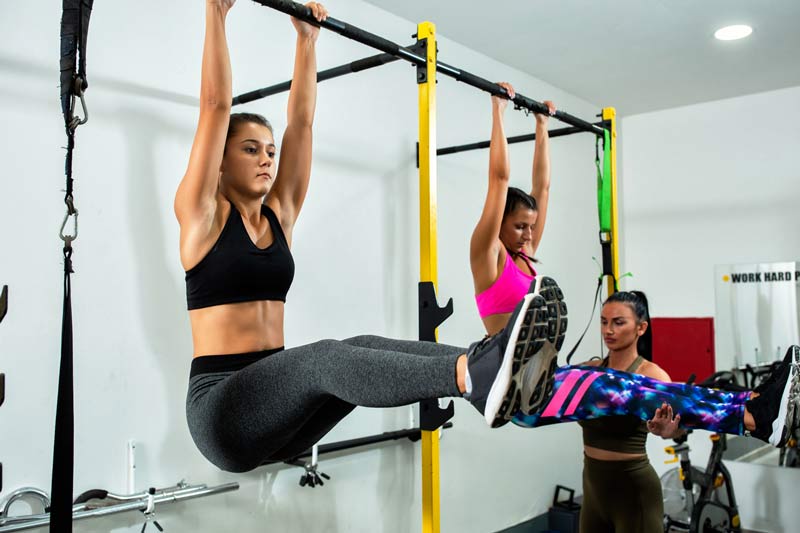
How to:
- Grasp the pull-up bar with a supinated grip.
- Hang down and raise your legs until they’re parallel to the ground. They should form an L shape.
- Inhale deeply and pull your body up whilst keeping your legs parallel to the ground.
- Slowly lower whilst exhaling and repeat.
90-degree Pull-up Hangs
90-degree pull-up hangs use two isometric movement patterns to combine a leg raise with a wide grip pull-up. They have several benefits including building core strength throughout your body but be warned, they are more of an advanced exercise.
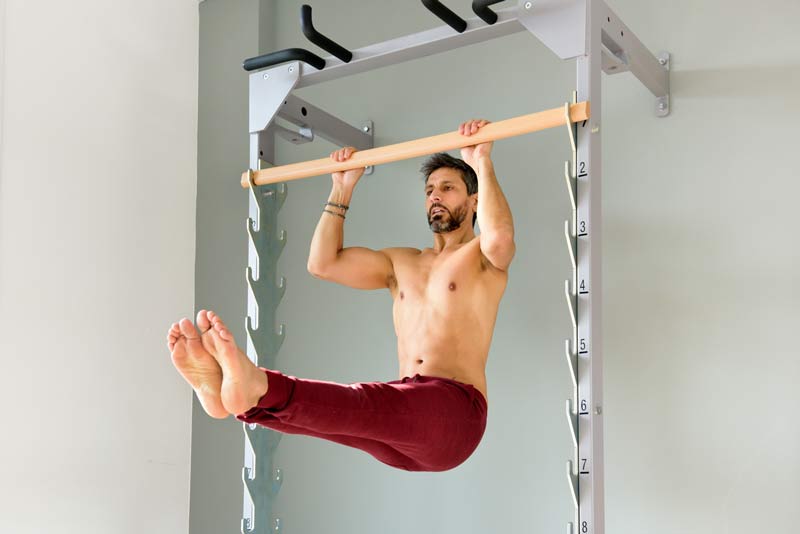
How to:
- Grasp the pull-up bar with a slightly wider shoulder-width grip.
- Take a deep breath in. Do a pull-up until your arms are at 90 degrees. At the same time, raise your legs.
- Hold the position. Exhale and return to the start.
Hanging Knee Raises
Hanging knee raises are great for improving functional strength and core stability. They use a similar movement pattern to 90-degree pull-ups without the isometric hold. Things don’t always have to be complicated!
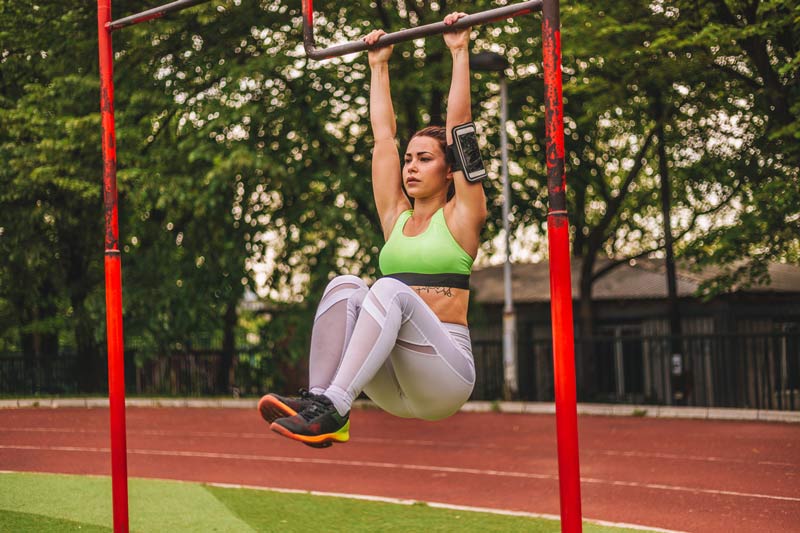
How to:
- Grasp the pull-up bar using a shoulder-width grip with your palms facing each other.
- Hang whilst making sure your arms are completely straight and your feet are off the ground.
- Take a deep breath in and raise your knees towards your shoulders. Hold the position briefly when they reach your chest.
- Exhale and return to the starting position. Repeat as required.
Around the Worlds
Around the world’s are an advanced ab exercise on a pull up bar that really challenges your full core musculature. Yes, they are hard and take some practice, but you’ll get there!
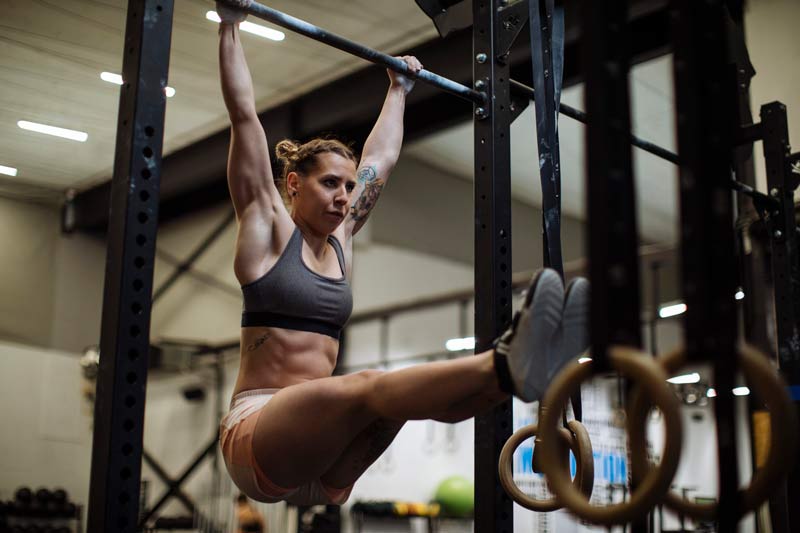
How to:
- Hang from the pull-up bar with your hands shoulder-width apart and palms facing each other.
- Inhale deeply then bring your legs around in a half-circle pattern. Aim for them to come up to the pull-up bar at the top of the movement.
- Pause briefly and rotate them the opposite way.
Inverse Pull-up Ladder Circuit
An inverse pull-up ladder circuit combines two popular exercises; pull-ups and press-ups. It provides some variety to your workout and helps to develop cardiovascular fitness as well as strength. Whilst they are last on our list, they are certainly not the least.
They are great when incorporated into a full-body workout circuit.
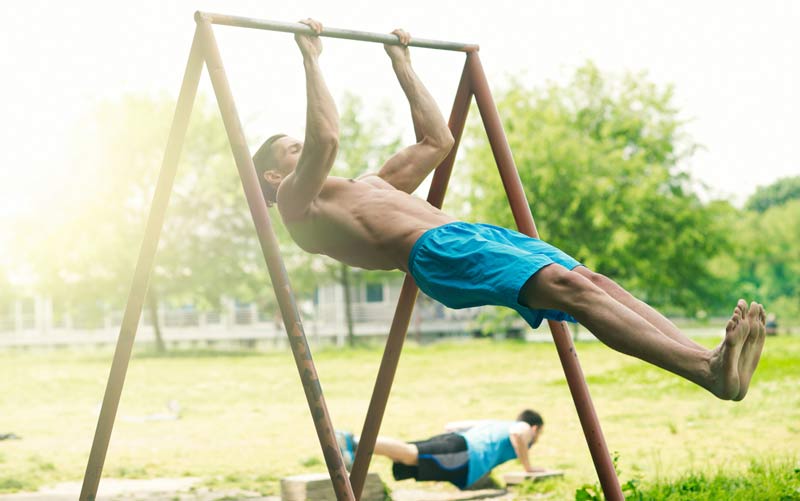
How to:
- Perform 10 pull-ups using the stated form above. Add in 1 press-up at the end of the set.
- Rest for 30 seconds.
- Now perform 9 pull-ups with 2 press-ups then rest.
- Continue until you’ve reached 1 pull-up and 10 press-ups.
- You can also reverse the ladder if you want.
Why Should You Have A Pull-Up Bar In Your Home Gym?
The reasons why you should have a pull-up bar in your home gym are endless. If you’ve read the amazing exercises above and still need some convincing, here’s why:
Improve Full Body Strength
Pull-ups require multiple athletic components to be performed correctly. They help to develop upper body and lower body strength, develop your core musculature and work on your grip strength.
Performing regular pull-up variations such as the ones stated above will build a solid back, chest, shoulders, arms, and core.
Develop Functional Fitness
Developing your pulling strength translates well into many everyday activities. Picking the shopping bags up and kids off the floor are two prime examples.
Pull-ups can be used to develop functional fitness using many upper-body and full-body movement patterns. The amount of versatile uses offered is endless when you add them to your workout routine.

GRAVITY FITNESS RESISTANCE BANDS – SET OF 4
- Durable and hard-wearing
- High quality latex construction
- Sold as a set of 4 bands
- 3-year warranty against manufacturer defects
Save Space In Your Home Gym
A pull-up bar is an excellent way to save space if you have a smaller home gym or you’re just simply looking for space-saving workout options.
They offer multiple movement patterns for one piece of gym kit and can be fixed to your ceiling or door frame. Finding space for your pull-up bar or station is easy with the right approach.
Offer Excellent Value For Money
Most pull-up bars are relatively inexpensive for what you get from them. They are well-constructed and can be used for many movements, offering excellent value for money.
Closing Comments
Pull-ups are a great way to build full-body strength, develop functional fitness, and improve your core. The exercises above are some of the best ones you can do using a versatile pull-up bar in your home gym.
So, what are you waiting for? Let’s get started!
References
- https://journals.lww.com/nsca-scj/fulltext/2014/06000/the_pull_up.14.aspx#:~:text=The%20pull%2Dup%20is%20a%20closed%20kinetic%20chain%2C%20multi%2D,swimming%20(3%2C5).
- https://pubmed.ncbi.nlm.nih.gov/21068680/












